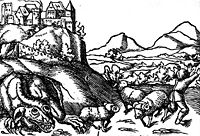Wawel dragon
The Wawel Dragon (in Polish: Smok Wawelski) is a famous fire breathing dragon in Polish folklore, also known as the Dragon of Kraków. According to the legend it lived in a cave under Wawel Hill in the early 8th century. The cave (which is today a popular tourist attraction) is on the banks of the Vistula river in Kraków, Poland. The dragon is said to have eaten nearby cattle and after many attempts to kill it, the beast was ultimately poisoned with sulfur by a man named Krakus who later became the monarch and namesake for the city.
History
The city (Kraków) is said to have been named after the legendary Polish prince (Krakus, Krak or Grakch) who killed the dragon and reigned from AD 730-750. It is one of the oldest cities in Poland and today the second largest. The earliest known settlement on the present site of Kraków was established on Wawel Hill, and dates back to the 4th century. It became the capital of Poland from 1038 to 1596. [1]
The first recorded mention of Krakus is in the Chronica seu originale regum et principum Poloniae from 1190.[2] He is credited with building Wawel Castle on Wawel Hill above the cave where the dragon had laired. Near the castle and cave is a statue of a dragon, in the image at right. The nearby Wawel Cathedral features a plaque commemorating his defeat by Krakus. It reads:[3]
- KRAKUS, A POLISH PRINCE RULED AD 730-750.
- HERE IS THE CAVE IN WHICH HAVING KILLED THE WILD DRAGON
- HE SETTLED AT WAWEL, AND FOUNDED THE CITY OF CRACOW.
- THIS INSCRIPTION WAS MADE BY STANISLAS JABLONOWSKI,
- PRINCE OF PRUSSIA AND CAPTAIN OF THE POLISH ARMY ARTILLERY[4]
- KRAKUS, A POLISH PRINCE RULED AD 730-750.
Krakus Mound, which exists to this day, was long believed to contain Krakus' remains, although recent archaeological work has revealed no grave. The mound has a diameter of over 50 meters and according to archaeologists, it was erected between the 8th and 10th centuries as a central element of an ancient grave site that no longer exists.[2]
Gargoyle of the dragon on the Wawel Cathedral, which is located on Wawel Hill.
Text of the Legend
Various version of the legend exist that share several themes in common, but differ on one key element, the identity of Krakus. One version places him as the one who poisoned the dragon, another as the king at the time.
| “ | Some centuries ago, the most horrible fire-belching dragon lived in a cave at the foot of the Wawel Hill, a monster that ravaged the nearby meadows by devouring grazing cattle. In vain The bravest knights tried to overcome the but dragon in vain. Before they could draw their swords, the fire from the beast's mouth killed them.
The king, who reigned at the time, (other versions identify the king as Krak[3]) sent out his heralds to announce that whosoever could kill the dragon would marry his daughter as a reward and sit on his throne after his death. Contenders encouraged by such a handsome offer came, but they were killed too. The king despaired, while the king's daughter wrung her hands not expecting ever to be married. The dragon-ravaged the country and it became poorer and poorer. Then a shoemaker named Krak (other versions of the legend identify the shoemaker as Skuba[3]) decided to conquer the beast by a unique strategy. After stuffing a fat ram with sulphur, he placed the tasty tidbit at the cave's entrance. The dragon, being greedy as well as stupid, swallowed the treacherous gift in one mouthful. Its throat burned so that it ran to the nearby The Vistula river, gulping down so much water that it burst with a great bang, thus the town and the surrounding countryside was freed of its terror. The shoemaker married the king's daughter, and after the monarch's death, ascended to the throne. The town, he rescued of the dragon, took its name from this shoemaker name and it bears to this day with great honour - the old capital of Poland, Krakow.[5] |
” |
Dragons
References
- ↑ History of Kraków by Wikipedia
- ↑ 2.0 2.1 Krakus by Wikipedia
- ↑ 3.0 3.1 3.2 Wawel Dragon by Wikipedia
- ↑ The Dragon's Lair by Cracow-life.com. Accessed July 28, 2010
- ↑ The Legend of Smok Wawelski (the Dragon from Wawel)
| |||||||||||||||||






